Posted by
Susan Sharma
on
July 08, 2007

Activists have long accused global corporations of being bad environmental citizens. But the problems of climate change and deforestation are part of a larger phenomenon, in which globalization is but one factor among many. As Nayan Chanda, editor of YaleGlobal,
discusses in his new book “Bound Together: How Traders, Preachers, Adventurers, and Warriors Shaped Globalization,” international consumer habits drive environmental devastation more so than globalized corporations. As a result, activists’ efforts could be
more productively directed at building an international consensus on pollution reduction, environmental regulation and sustainable development.
Powerful new advances in communications technology relay the realities of environmental degradation and natural disasters to the world’s public more quickly than ever before. Activists are the new preachers in a modern world – and the immediacy of technology
gives them unprecedented opportunities to convey their message of morality to a global audience. Building powerful movements with online blogs and instant-chat programs, environmentalists must admit that globalization might not be so bad. – YaleGlobal
Nayan Chanda
http://yaleglobal.yale.edu/display.article?id=9366
|
Posted by
Susan Sharma
on
July 06, 2007

As global warming continues, natural habitats will change. In theory, animals would move as their habitats became too warm, but due to the pace of global warming, experts worry that some animals won’t have time to adjust and could go extinct.
Conservationists therefore propose building biological corridors, natural spaces connecting habitats, that would allow wildlife to relocate. But people and development block some of the most logical routes. Most wildlife-assistance organizations don’t have
the money to buy land, and displaced people would add to environmental destruction.
In Costa Rica, wildlife organizations encourage local residents living along the national park La Amistad to grow organic coffee. The arrangement is environmentally friendly and attracts tourists, bolstering local income. Such local and private efforts are
small in scale – and slowing the pace of global warming, protecting biodiversity and a way of life for many communities in any lasting way, requires government action and international cooperation.
Source: http://yaleglobal.yale.edu/display.article?id=9400
|
Posted by
Susan Sharma
on
July 06, 2007

Motorcycles typically get about double the gas mileage of even the most fuel-efficient cars—but that doesn’t mean they are green. They spew up to 15 times more pollution per mile, mostly in the form of smog-causing hydrocarbons and nitrogen oxides.
CSE Findings
The Green Rating of Indian Industry project was started by the Centre for Science and Environment (CSE) in 1996. According to CSE, among the two and three wheelers, models of Hero Honda (Splendor and CD 100) are the most eco friendly two wheelers. They
have scored above average in vehicle and engine design and are one of the very few four-stroke two wheeler fitted with any kind of pollution control equipment.
Bajaj boxer, has scored well in vehicle and engine design but lacks in emission control equipment and comparatively poorer emission.
The best performing two-stroke model ranks fourth amongst the two wheelers. The lowest score has been obtained by Kinetic Safari moped, which obtained average scores in design and emissions and very poor scores in pollution control equipment and emissions.
Battery powered?
In the meantime, Evera Auto India is set to launch a battery powered motorcycle in the northern states of Delhi, Uttar Pradesh and Uttarakhand in July.
The company based in Firozabad (Uttar Pradesh)is hoping to corner a niche segment in the expanding two-wheeler market with the launch of the eco-friendly vehicle. The motorcycle has been built indigenously and will be launched in the third week of July according
to Mukesh Bansal, promoter of Evera Auto India.
A battery that runs a 250-watt motor powers the motorcycle, making it a non-polluting vehicle. After being charged for six hours, the motorcycle can run for 80 km at a maximum speed of 25 km per hour.
"Till now, the electric powered motorcycles that were available in India were imported from China. We have worked over the technology of this motorcycle for the last two years," Bansal said.
"We are targeting a specific class who have to travel 10-15 kilometres everyday. The running cost of the vehicle is extremely low. The only price that the owner has to pay is the charging cost of the battery."
The motorcycle will be priced somewhere between Rs 25,000 and Rs 32,000 ($600-780) and the company expects a good sale in the first year of its launch.
( Source: Various Media reports )
|
Posted by
Susan Sharma
on
July 05, 2007
"The Great Indian Tiger Crisis" won the award for Best Point of View at the International Wildlife Film Festival 2007 at Montana, USA
Synopsis
The Great Indian Tiger Crisis
Mirror Films Private Limited
Producer: Arindam Mitra
India was shocked to learn, in early 2005 that some of her Tiger Reserve Forests had actually no tigers left. The Prime Minister set up a task force with eminent conservationists and sent them out on a fact finding mission across the length and breadth of
the vast number of Reserve Forests. This film stalks the task force to unearth shocking facts and becomes an important critique of the conservation policies in India. Part road movie, part fact finding, part political discourse and part philosophy this is
a fascinating piece of film too. (77 min)
|
Posted by
Susan Sharma
on
July 05, 2007
"The Great Indian Tiger Crisis" won the award for Best Point of View at the International Wildlife Film Festival 2007 at Montana, USA
Synopsis
The Great Indian Tiger Crisis
Mirror Films Private Limited
Producer: Arindam Mitra
India was shocked to learn, in early 2005 that some of her Tiger Reserve Forests had actually no tigers left. The Prime Minister set up a task force with eminent conservationists and sent them out on a fact finding mission across the length and breadth of
the vast number of Reserve Forests. This film stalks the task force to unearth shocking facts and becomes an important critique of the conservation policies in India. Part road movie, part fact finding, part political discourse and part philosophy this is
a fascinating piece of film too. (77 min)
|
Posted by
Susan Sharma
on
June 29, 2007
Here is an amusing story from Ahmedabad. A flock of sparrows has been pecking at three friends living in Ahmedabad since three days. The pecking is so severe that the men cannot go out of their homes and one day the birds even chased the men nearly a kilometer
away.
It all started from an effort by Shastri and his friends to help two fledglings, which fell from their nest after being attacked by a cat in his frontyard. "The sparrows thought we had killed her babies and started pecking us on the head." said Shastri.
The friends thought that was the end, but in the evening, they were attacked again by the sparrows near a pan shop. The next day too, the sparrows had not forgotten them. The men are now planning ways to sneak out of their homes.
Source Times of India June 29, 2007
|
Posted by
Jacob Koshi
on
June 27, 2007

A visit to Kruger Park in South Africa
-Jacob Koshi M
Flights to South Africa from India are operated by Qatar Airways, Emirates, South African Airways etc. One can book tickets through the travel agent or directly through the internet.
In case of planning to club with visits to another country, request for Multiple Entry visas from the South African Embassy in Mumbai. Booking can be made through the net for stay in the tourist lodges or hotels near the Kruger Park. I stayed in a resort
called Kruger Park Lodge which is close to Kruger Park. Bookings can be made through the internet to this place. Or if one is a member of Mahindra Resorts or RCI, they have affiliations to this place.
For those who intend to visit the Kruger Park, the following description & tips will help in planning the trip.
Johannesburg to Nelspruit 350 kms Nelspruit to Whiteriver 23 kms Whiteriver to Hazyview 45 kms Hazyview to Paul Kruger Gate 41kms. Total = 459kms
City bug (the 14 seater minibuses) operates from Joberg airport to Hazyview for Rand 200/- You can book your tickets online on www.citibug.com & pay using your credit card sitting in India. The driver will have a computerised list of passengers. Show them
your identity & he will take you in. There are other minibus operators also through whom you can book your tickets. Book your tickets both ways mentioning your date of journey & date of departure. For travel from Hazyview to Kruger Park Lodge (which is outside
the Kuger Park), one can email & request for the Lodge’s vehicle for pickup for this small distance. This way, one can save lot of money for transport.
The lodge will arrange pick up from Joberg airport, but the rates will be prohibitively expensive. Once inside the resort, book your trips with tour operators who liaise with the lodge. Give them your preference of next day’s trips (they will explain over
the phone the type of trip, rate etc) & your credit card number as security, they will collect you from your chalet at the preset time & drop you back after the trip.
In my case, I have booked a jeep safari trip starting at 5.45am & ending at 12.30pm. Carry some cloths for the cold weather. The Kruger Park Lodge is an upmarket resort with spotless cleanliness & equipped with all the necessary things required for stay.
If you want to avoid using the restaurant for all the meals, (The restaurant & office building is some distance away from your chalet) buy breakfast items, eggs etc from the supermarket which is close to the lodge, but outside the lodge & store in the fridge.
The restaurant food is purely continental & provide for lunch or dinner. Besides, beer is very cheap & is available at restaurants. International credit cards issued from India are acceptable for payment in South Africa.
Cell phones have full range even in the remotest area since connectivity is through the satellite. So, it is advisable to carry your cell phones from India for calling anywhere in the world. (You should take a SIM card with international roaming facility
to call or receive, the rates of which have come down considerably after my visit) Carry your camera, binoculars & a powerful torch for viewing animals at night like deer, hippos etc at night from your chalet.
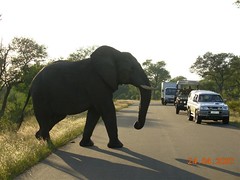
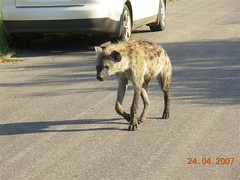
Kruger Park visit can be clubbed with a visit to diamond & gold mines on your return to Johannesburg. All purchase made in SA will be charged VAT which can be claimed back at airports of departure in the prescribed counters.

Jacob Koshi M ( Click on the photo)
|
Posted by
Susan Sharma
on
June 25, 2007


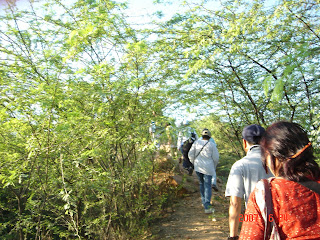
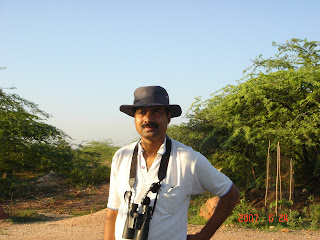

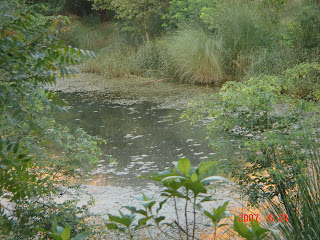
Nature does not protest, it adapts!
The Delhi bird Group organized a Sunday morning walk in the Aravali Biodiversity Park, Vasant Kunj, New Delhi. Here are some thoughts from the walk.
The Aravali Bio diversity Park is formed out of degraded land reclaimed from the business house of Scindias who had a mining lease for the 2.3 sq.km area. This means that anything that can be plundered out of the forest/earth including mica, sand and water
have all been taken out.
So instead of the sprawling forest the ridge was once, we have land pockmarked by pits and hillocks with "Vilayati Keekar" growing all over, thanks to the areal seeding done by the forest department.
2004- Enter the DDA and Delhi University. The pits are cemented (with biodegradable slurry) to encourage rainwater retention. Native trees are planted under a systematic planting program to slowly remove the "Vilayati Keekar", which being an exotic species
do not harbour native insects or birds.
June 2007 - A group of nature lovers take a walk in the Park. Dr. M.Shah Hussain along with Dr.Yasir lead the walk.
Coppersmith! little cormorant in flight! Koyal! Parakeets! The birders are excited at almost every turn.
As we walked on, Indian Robin, Red Vented Bulbul, White Eared Bulbul, Purple sunbird, common Mynas, Wren Warbler and some flying Black kites become common sightings during the trail. Plain tiger butterflies and blue pansy flitted about in the area
where native vegetation has started taking root.
At least a couple of peacocks showed up close; though the morning was pierced by their calls often.
Every now and and then a thundering sound of planes taking off from the airport nearby kept reminding us we are not far from an international airport.
As we reached the periphery of the park, a bevy of peahens took off into the air. Monsoon is expected in a week, and all of them must be having eggs about to be hatched or just hatched chicks. A group of over 30 walkers would have set the alarm calls for them.
They have chosen the nursery space carefully-slightly higher ground with thick bushes so that rainwater will not harm them.
Do peahens also tend to remain close to each other while raising the young? So that they can forage by turn may be? Do peahen mothers care for peachicks not their own?
At the end of the walk, one was amazed at the manner in which nature adapted. The mining pits are now small water holes attracting water cocks and cormorants-Cementing the areas with bio degradable materials -the little bit of egging on by the CEMDE, Delhi
University (Center for Environment Management & Degraded Ecosystem), is rejuvenating the forest.
Selective planting of native species like Berry, Jamun,Khiorni, Guava and Anar trees etc. are automatically collecting around them the natural biotic creatures-birds, butterflies, ferrals.
Nature does not protest but adapts!
Photographs in order of appearing
1.The soil is rich in Mica
2.Walkers in single file
3.Dr. Husain
4.Bird watcher
5. Natural lake
See photographs of som eof the birds and butterflies at DelhiBird
by clicking here
http://tinyurl.com/2t5mfy
[Open in new window]
|
Posted by
Susan Sharma
on
June 22, 2007
Comments, objections and suggestions on the draft Scheduled Tribes and Other Traditional Forest Dwellers (Recognition of Forest Rights) Rules, 2007, are being invited by the Ministry of Tribal Affairs, New Delhi to reach by the 6th of August 2007.
Comments can be sent by email too.
A copy of the Act as well as the draft rules can be viewed in the website
http://www.tribal.gov.in
|
Posted by
Susan Sharma
on
June 22, 2007

Delhi Cycling Club is organizing a bicycle rally India Gate-Red Fort at 7.AM 0n 24th June 2007
to create awareness about various benefits of cycling; Promote road safety amongst cyclists;and demand from the Government the much needed cycle
tracks on all main roads of Delhi.
About
DELHI CYCLING CLUB:
Formed by ITDP India in April 2007, Delhi Cycling Club is a forum of bicycle enthusiasts, health and environmental conscious citizens in
New Delhi.
The club has been engaged in carrying out the following activities:
- Creating public awareness and sensitization
about the environmental, health, economic, energy and other benefits of bicycling.
- Educating various decision makers and stakeholders about the need and advantages of promoting cycling and NMT in our cities and integrating them with
other modes of transportation.
- Demanding fast implementation of better and safe cycling infrastructure in
Delhi from the Government.
- Planning regular traffic safety programmes for bicycle users in association with other NGOs and Traffic Police especially amongst the students and
factory workers who are more vulnerable to accidents.
- Planning and organizing regular bike trips on various themes
such as Heritage Biking, Excursion trip, adventure trips, and bike rallies etc.
About ITDP
INDIA:
The Initiative for Transportation and Development Programmes (ITDP India) is a Delhi based NGO involved in the research and advocacy of Bus Rapid Transit
System (BRT) cities and non motorized transportation. The organization is the
India chapter of
New York based Institute for Transportation and Development Policy (ITDP). ITDP is dedicated to the promotion of transportation policies
and projects which are environmentally, socially and economically sustainable as well as equitable.
|